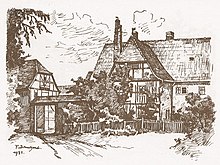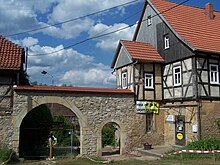Trenkelhof

Trenkelhof is a Guts- homestead in the independent city of Eisenach in Thuringia .
location
The Trenkelhof is located on the northeastern edge of the core city of Eisenach. To the north and east, the Trenkelhofer Flur borders on Stockhausen and Großenlupnitz , to the southwest the Flur von Fischbach follows - now the district of Eisenach with the Hofferbertaue part of the settlement immediately to the southwest . The federal highway 88 (former section of the federal freeway 4 ) runs at Trenkelhof and the federal highway 84 to the west . The geographic height of the place is 246.8 m above sea level. HN .
history
On July 28, 1433, the manor was first mentioned in a document. At that time, the Hof am Tregelbach was owned by the Landgraves of Thuringia, and it was under the jurisdiction of the Wartburg Office. Around 1500 Jost Holze von Furthe (today Förtha ) and Wolfram Kreuzburg von Windischensuhla (today Wünschensuhl ) acquired the estate, they soon fell into debt dependency on the Lords of Erffa , after the Peasants' War both parts of the farm were owned by the Erffas from 1530. An Eisenach patrician family Wachsmuth is named as the successor to the two unsuccessful tenants, who renew the estate with economic success. Around 1598 Gut Trenkelhof was one of the most valuable possessions in the Wartburg office, which is why the first Duke of Eisenach, Johann Ernst, bought it as a private property for 6,000 guilders. Lush celebrations and hunts took place here, the manor was far outside the city walls of Eisenach. After the death of Duke Johann Ernst, who died childless in 1638, the heirs separated from the estate, which was handed over to the court servant Franz Rasch for 3000 guilders . The buyer took a big risk, because the Duchy of Saxony-Eisenach was still in a state of war at the time - in the previous year, the imperial and Swedish cavalry bands fought several battles in the area around Eisenach.
After the rebuilding of the country, Duke Johann Georg I of Eisenach acquired the Trenkelhof again in 1668 as a private property. At that time the farm had 386 acres of arable land, 30 acres of meadows and three ponds.
After the double battle of Jena and Auerstedt , the Napoleonic occupation of the Thuringian duchies followed, and the first transports of prisoners also passed through the Eisenach area. Three days after the battle, on October 17, 1806, the Prussian lieutenant Friedrich Hellwig, who had gotten behind enemy lines, was at Trenkelhof with 50 hussars. His scouts reported to him a column of French prisoners of war coming from Gotha on the approach to the neighboring village of Eichrodt . With a surprise attack, Hellwig managed to take the French guards by surprise and free the prisoners, the Hellwig monument on the outskirts of Wutha-Farnroda commemorates the events . The retreating army of Napoleon's army, defeated in the Battle of Leipzig , plundered the towns and farms along the military roads as they retreated. On October 26, 1813, another battle took place at Trenkelhof, where the Prussian lieutenant Ferdinand von Mauderode was killed, his grave is in the Großenlupnitz cemetery. A mass grave with French dead from 1813 was discovered in 1938 by the archaeologist Dr. Karcher from Eisenach on the southwestern edge of Großenlupnitz exposed.
The community of Großenlupnitz received a request from the grand ducal military administration in 1866 to provide a maneuvering area on the Kleiner Hörselberg and Trenkelhof. The field name Generalshügel for a hill in front of the hill southeast of the Leimenberg got its meaning.
In the 19th century the Trenkelhof was designated as a chamber property. The corridor was 233.15 acres; 21 residents lived on the farm, which was parish and schooled in Großenlupnitz. In 1881 the estate was transferred to a domain, the domain leaseholder was Felix Bornemann until 1901 , he belonged to the Bornemann family, who, as operators of the Eisenacher share brickwork and property speculation, belonged to the richest industrialists in the Wartburg city after the Eichel-Streiber family.
The Hofferbertaue residential area was built in the south of the Trenkelhof in 1932 . The settlement there was developed with the support of the Eisenach city administration and was to be enlarged in the 1940s with an expansion to the east on Leimenberg. At the same time, construction work began on the BMW engine plant at the neighboring Dürrerhof - about a kilometer away. After the outbreak of the Second World War , the city administration under Lord Mayor Dr. Müller-Bowe to acquire the Trenkelhof for the city after tough negotiations. The incorporation took place in March 1941 and had the goal of establishing a new district with 100 settlement plots. The plan only came to fruition in the rudimentary form; a first group of settlement houses was built along the main road to Hofferbertaue in the 1940s. After 1945 the property was initially used for emergency supplies to the Eisenach population and was not expropriated as municipal property. The city administration under Mayor Karl Hermann decided to distribute some properties to new farmers. In the 1950s, a small LPG was founded at Trenkelhof . In addition to sheep farming and cattle rearing, a broiler production facility was built in the 1970s. After the fall of the Wall, the property was again owned by the city of Eisenach. A private owner bought the property in 1998 and ran a stud farm with boarding horses. The property has been for sale since 2015.
The Eisenach animal shelter has been located in the former broiler farm since 1993.
Personalities
The painter Felix Schuchard was born on the Trenkelhof in 1865 and died on April 19, 1944 in Eisenach.
Web links
Individual evidence
- ↑ Official topographic maps of Thuringia 1: 10,000. Wartburgkreis, district of Gotha, district-free city of Eisenach . In: Thuringian Land Survey Office (Hrsg.): CD-ROM series Top10 . CD 2. Erfurt 1999.
- ^ Wolfgang Kahl: First mention of Thuringian towns and villages. A manual. Rockstuhl Verlag, Bad Langensalza, 2010, ISBN 978-3-86777-202-0 , p. 288.
- ↑ a b c d U.N .: The Trenkelhof bought from the city of Eisenach. Land for 100 new settler sites . In: Eisenacher Zeitung . Eisenach March 29, 1941.
- ^ Hagen Jäger: Contributions to the history of Großenlupnitz (779-2004) . Ed .: Community administration in Großenlupnitz. Großenlupnitz 2004, p. 14-15, 31 .
- ^ Hagen Jäger: Contributions to the history of Großenlupnitz (779-2004) . Ed .: Community administration in Großenlupnitz. Großenlupnitz 2004, p. 31 .
- ^ Günter Wenzel: Eisenach 1945–1952 . In: Eisenach writings on local history . Issue 42. Eisenach 1989, p. 70, Appendix 4 .
- ↑ various: Series of articles on the Trenkelhof . In: Eisenacher Current Newspaper . Eisenach (1960-64).
- ↑ a b tierschutzverein-eisenach.de accessed on August 17, 2012
- ^ Eisenach: Trenkelhof steeped in history is for sale. Eisenacher Presse from August 1, 2015 , accessed on February 7, 2016
Coordinates: 50 ° 58 ′ 33.3 " N , 10 ° 22 ′ 20.2" E






